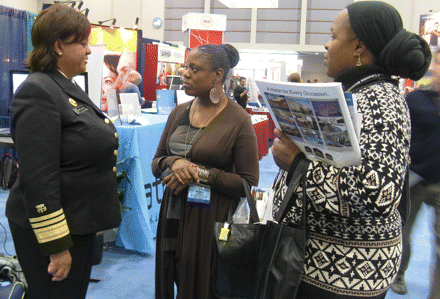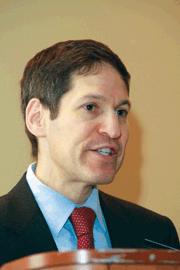The interconnection between physical and mental health and the way in which communities can influence them took center stage during APHA’s 139th Annual Meeting in Washington, D.C., this fall.
Held Oct. 29–Nov. 2, the meeting offered breaking public health research, discussions with national public health leaders and insights into what is in store for the field. Encompassing everything from scientific and poster sessions to career events and business meetings, the Annual Meeting attracted more than 13,000 attendees from across the U.S. and around the world.

Photo courtesy EZ Event Photography
“We had both strong attendance and engagement at the meeting,” said APHA Interim Executive Director Alan Baker, MA. “It shows that even in this economy, advancing public health science and sharing best practices is highly valued.”

Above, a presenter discusses research at a poster session at APHA’s 139th Annual Meeting. Center photo, attendees at a Sunday night event direct questions to session panelists.
Photo courtesy EZ Event Photography
Throughout the five-day event, the meeting’s theme of “Healthy Communities Promote Healthy Minds and Bodies” was high on the agenda, especially during the meeting’s opening session on Sunday, Oct. 30.
Keynote speaker Pamela Hyde, JD, administrator of the Substance Abuse and Mental Health Services Administration, noted the importance of a strong, community-wide system to help people deal with substance abuse and mental health issues. Mental health issues alone are projected to cost $16 trillion worldwide over the next 20 years, she said, and half of all U.S. adults will experience a mental health issue during their lifetimes.

Pamela Hyde, administrator of the Substance Abuse and Mental Health Services Administration, speaks at the Annual Meeting.
Photo courtesy EZ Event Photography
“We’re not looking at the big picture,” she told the thousands of attendees on hand for the opening session. “We’re thinking of these as a social problem rather than a public health problem. We want to create a dialogue that changes this.”
Behavioral health is the nation’s top public health challenge, Hyde said, noting that drug deaths outnumber traffic fatalities, and that suicide deaths outnumber homicides and deaths from AIDS. Unfortunately, many Americans with mental illness and substance abuse disorders fail to get treatment.
“Behavioral disorders are very common, almost as common as a broken limb,” Hyde said. “It would never occur to us not to seek treatment for a child who broke his wrist.”
Physical health is also important to overall wellbeing, and the outdoors can play a key role, said fellow keynote speaker Jonathan Jarvis, director of the National Park Service. Parks, he said, can serve as the “lungs of a city,” and national parks and green spaces are “important and overlooked” places where people can exercise.

Jonathan Jarvis, director of the National Park Service, speaks about the connection between parks and health at the Annual Meeting opening session. Jarvis was one of three keynoters.
Photo courtesy EZ Event Photography
Jarvis said earlier generations of Americans “had an innate grasp of ‘go outside and play’” that today’s young people may not understand. Parks encourage “spontaneous, unstructured activity,” particularly in children, that can be carried throughout life.
Jarvis highlighted collaborations such as one with the city of Little Rock, Ark., in which the National Park Service established a trail system known as the “Medical Mile,” which offers exhibits and other educational media. It focuses on health and “serves as a catalyst for lifestyle change,” he said.
To further make the connection between parks and health, the National Park Service — which has its own office of public health — has a program featuring “park prescriptions.” Doctors who are part of the program can prescribe a visit to a park to their patients.
“We call this, ‘Take a hike and call me in the morning,’” Jarvis said.
Opening session speakers also touched on the challenges ahead in the U.S. health system, such as resistance to health reform. Risa Lavizzo-Mourey, MD, MBA, president and CEO of the Robert Wood Johnson Foundation, who received APHA’s Presidential Citation during the meeting, told attendees that the road ahead would be hard.
“It will take…all that you can muster,” she said. “But that is exactly what you do so well. You are too important to ignore.”
The uncertain future of health in America and the need for advocates to rally was underscored by Tom Daschle, former Senate majority leader, who closed out the opening session keynote speakers.

Former Sen. Tom Daschle calls on attendees at APHA’s 139th Annual Meeting opening session to be advocates for health.
Photo courtesy EZ Event Photography
“Our country is deeply divided,” he said, noting that some Americans have not yet been convinced that health should be a human right.
But there is a nationwide consensus for what the country’s health goals should be, he said, noting that America “needs and deserves a high-performance, high-value health care system” based on better access and higher quality.
Passing the Affordable Care Act in 2010 was the beginning, Daschle said, not the end.
“I don’t know that we’ve ever needed you more than we need you this year, in this fight,” Daschle said. “We’ve exhausted every other possibility. We know the path we need to take. I have every confidence to the bottom of my heart and soul that this, too, can be done.”

Gil Kerlikowske, director of the White House Office of National Drug Control Policy, speaks to APHA’s Executive Board. From right is board Chair Susan Radius, PhD, CHES, and APHA Interim Executive Director Alan Baker, MA.
Photo by Teddi Dineley Johnson
The call to action in support of public health carried on throughout the Annual Meeting, leading up to the closing session on Wednesday, where incoming APHA President Mel Shipp, OD, DrPH, MPH, called on APHA and its members to be a “vanguard” for public health and make sure that the Affordable Care Act is not eroded or overturned.
“This coming year will be important — no, critical — for public health,” Shipp told the audience at the closing session, which engaged participants around protecting occupational health.
While the U.S. has made great strides in the past century in protecting the health of its workers, too many workers still are needlessly injured or die, according to speakers at the closing session, who included federal and private sector occupational health leaders.
While high-profile events such as mining disasters or workplace explosions make the news, daily on-the-job deaths from heat, car crashes or other activities do not garner the same media attention, said session speaker David Michaels, MD, PhD, administrator of the Occupational Safety and Health Administration.
Each year, more than 4,000 workers die of workplace injuries, with the health care industry the leader in job-related injuries. The fact that such deaths and injuries still occur shows the importance of occupational health standards, Michaels said. However, some of those protections are under attack from politicians who erroneously label them as “job killers,” he noted.
“OSHA standards don’t kill jobs,” said Michaels, who is an APHA member. “They stop jobs from killing workers.”
The need for strong occupational health and safety standards for workers goes well beyond U.S. borders, said fellow closing session speaker Leo Gerard, international president of United Steel Workers. Around the world, workers who are creating goods for American consumers are put at risk of injury or death because their countries lack adequate protections, Gerard said.
Globalization should not be used as an excuse to put workers in other countries at risk, nor to erode protections in America, Gerard said. If occupational health advocates do not speak up, he said, “we’ll be allowing workers in other countries to be killed as we stand silent. And we can’t stand silent.”
While the opening and closing sessions were big draws at the Annual Meeting, attendees had the opportunity to hear from high-profile public health leaders throughout the event. Tom Frieden, MD, MPH, director of the Centers for Disease Control and Prevention, spoke to a packed scientific session, while U.S. Surgeon General Regina Benjamin, MD, MBA, visited with attendees at the Annual Meeting Exposition. Other well-known leaders that took part in scientific sessions included U.S. Assistant Secretary for Health Howard Koh, MD, MPH; Miguel Gomez, director of AIDS.gov; and Sens. Tom Udall, D-N.M., and Bernie Sanders, D-Vt. During its business meeting, APHA’s Executive Board met with Lisa Jackson, administrator of the Environmental Protection Agency, and Gil Kerlikowske, director of the White House Office of National Drug Control Policy.

Lisa Jackson, administrator of the Environmental Protection Agency, speaks with members of APHA’s Executive Board.
Photo by Michele Late
Beyond presentations, Annual Meeting attendees were able to use the APHA Annual Meeting to improve their public health knowledge at the expo, network and receive continuing education credits. They also took advantage of social media, using tools such as Facebook and Twitter to connect with fellow attendees and share their thoughts about the meeting.

Surgeon General Regina Benjamin, MD, MBA, speaks with APHA Annual Meeting-goers during a stop at the expo.
Photo courtesy Kim Krisberg
Twitter users were particularly active during the Annual Meeting, posting more than 6,000 tweets with the Annual Meeting hashtag, #apha11, during the conference. Attendees also used social media tools to post photos, leave comments and hold conversations.
APHA’s Annual Meeting Blog was a key attraction during the meeting, both for attendees and those who were following the meeting from afar. The blog featured news about the meeting as it happened, publishing almost 60 posts. The entries are online at http://aphaannualmeeting.blogspot.com, and comments are welcome.
Speeches from the opening session, including those from Hyde, Jarvis and Daschle, can be watched on APHA’s YouTube page at www.youtube.com/aphadc. Meeting attendees who took photos at the event are encouraged to add them to APHA’s Flickr pool, online at www.flickr.com/groups/aphapublichealth.
Meeting attendees who want to replay a scientific session they attended or take in one they missed can do so through APHA’s E-ssentialLearning program. The program offers online access to thousands of recordings of scientific sessions from the Annual Meeting. For a fee, the program allows Web users to listen to presentations from Annual Meeting scientific sessions and view related PowerPoint presentations.

CDC Director Tom Frieden speaks at a scientific session.
Photo courtesy EZ Event Photography
E-ssentialLearning is particularly popular with people who made scientific presentations at the meeting, as they can listen to recordings of their presentations. Presenters receive discounted rates for subscribing to the program, which can be accessed at www.apha.org/meetings/annualmeeting.
Additionally during the meeting, attendees raised $5,600 through APHA’s annual Help Us Help Them campaign, which gives back to the meeting community. The donation was presented to Community of Hope, a Washington, D.C., nonprofit that provides services to homeless and low-income people, including social services and health care.
The 2012 APHA Annual Meeting, which will have a theme of “Prevention and Wellness Across the Lifespan,” will be held Oct. 27–31 in San Francisco.
Abstract submissions are now being accepted for the meeting (see Page 3).
For more on APHA’s past and future Annual Meetings, visit www.apha.org/meetings, call 202-777-2742 or email comments{at}apha.org.
Charlotte Tucker contributed to this report.
- Copyright The Nation’s Health, American Public Health Association









